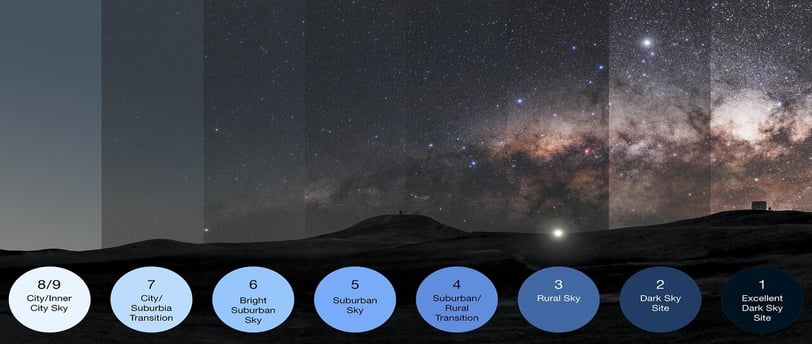The Sky: A Rising Resource in Tourism
The sky is a natural treasure that fascinates people and is emerging as a new source of tourism. In this article, discover the effects of light pollution, the Bortle Scale, dark sky parks and how you can protect the sky with IDA certification. Also, learn about the consultancy services we offer as Dark Sky Tour for the installation of dark sky parks.
9/18/20242 min read


The sky has fascinated and inspired humanity for centuries, and in the modern world, it's becoming a valuable resource for tourism. However, the rapid increase in light pollution is making it harder to experience the beauty of the night sky. This challenge has given rise to astrotourism, a growing trend that turns the night sky into a unique tourism asset. With efforts to protect dark skies and establish special observation areas, astrotourism is gaining momentum worldwide.
Light Pollution and the Bortle Scale
Light pollution, caused by excessive artificial lighting in urban and industrial areas, dims the natural darkness of the sky, making it harder to observe stars and other celestial bodies. The Bortle Scale is used to measure the level of darkness in a given location, ranging from 1 (the darkest) to 9 (the brightest). This scale is crucial for determining the quality of sky observation.
Bortle 1-2: Nearly pristine skies with no light pollution.
Bortle 3-4: Slight light pollution, but still suitable for stargazing.
Bortle 5 and above: Areas with significant light pollution where stargazing is severely impacted.
For optimal astrotourism experiences, Bortle levels 1 to 4 are ideal, as they provide the clearest and most natural views of the stars, planets, and even deep-sky objects.
Dark Sky Parks and IDA Certification
Dark Sky Parks are designated areas where efforts are made to minimize light pollution and preserve the natural night sky. These parks offer a unique opportunity for tourists to experience the wonders of the universe. The International Dark-Sky Association (IDA) certifies these areas, ensuring that they meet specific criteria to maintain sky quality and offer sustainable astrotourism experiences. To achieve IDA certification, an area typically needs to fall within Bortle 1-4 levels, ensuring that the sky is dark enough for astronomical observation.
These parks are not only valuable for tourism but also play a crucial role in raising awareness about light pollution and its impact on both the environment and human health. They provide an opportunity for people to reconnect with nature in a way that modern city life often prevents.
How to Reduce Light Pollution
There are several steps that can be taken to reduce light pollution and protect the night sky:
Directed Lighting: Using lighting fixtures that minimize upward light spillage.
Energy-efficient bulbs: Choosing bulbs that use less energy and reduce unnecessary light scatter.
Timers and motion sensors: Installing lighting systems that only operate when needed.
Public awareness: Educating communities about the negative impacts of light pollution and encouraging responsible lighting practices.
Dark Sky Tour and Dark Sky Park Consulting
At Dark Sky Tour, we are dedicated to preserving the night sky and promoting sustainable astrotourism. Our team of experts offers comprehensive consulting services for the development and management of IDA-certified Dark Sky Parks. We assist businesses and communities in evaluating their sky quality, guiding them through the certification process, and helping them implement necessary measures to reduce light pollution.
By establishing dark sky parks, we can offer tourists a chance to reconnect with the beauty of the stars while promoting environmental conservation. The sky is not just a breathtaking view; it is a source of wonder and inspiration that should be protected for future generations. At Dark Sky Tour, we are proud to play a part in safeguarding this invaluable resource and helping astrotourism thrive.
